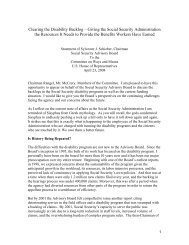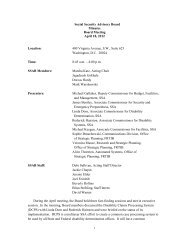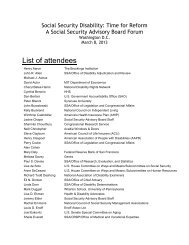Aspects of Disability Decision Making: Data and Materials
Aspects of Disability Decision Making: Data and Materials
Aspects of Disability Decision Making: Data and Materials
Create successful ePaper yourself
Turn your PDF publications into a flip-book with our unique Google optimized e-Paper software.
1980 In response to rapid growth <strong>of</strong> the <strong>Disability</strong> Insurance <strong>and</strong> SSI disability programs in the 1970s,Congress passed The Social Security <strong>Disability</strong> Amendments <strong>of</strong> 1980 (P.L. 96‐265), which modifiedthe DI benefit computation <strong>and</strong> included provisions that required the government to:■■issue regulations defining performance st<strong>and</strong>ards for State disability determination services(DDSs), the State agencies that make disability decision for SSA;■■review a specified percentage <strong>of</strong> DDS allowances before paying benefits;■■assume the disability determination function from a DDS if the DDS substantially fails t<strong>of</strong>ollow Federal regulations <strong>and</strong> guidelines or if the State no longer wishes to make the determinations;■■implement a program to review decisions made by SSA administrative law judges (ALJs) <strong>and</strong>report to Congress on the progress <strong>of</strong> the program; <strong>and</strong>■■review the status <strong>of</strong> disabled individuals with non-permanent disabilities at least every threeyears (by conducting continuing disability reviews, or CDRs).The amendments also contained a number <strong>of</strong> provisions designed to encourage DI <strong>and</strong>/or SSI disabilitybeneficiaries to return to work, including:■■continuation <strong>of</strong> benefits while a beneficiary is in vocational rehabilitation;■■disregard <strong>of</strong> certain impairment-related work expenses when determining whether the individualis engaging in substantial gainful activity;■■re‐entitlement to benefits for individuals whose attempts to return to work prove unsuccessful;<strong>and</strong>■■extension <strong>of</strong> Medicare coverage for individuals after benefits cease due to work activity.The amendments also included temporary authority for return-to-work demonstration projects<strong>and</strong> administrative provisions that limited the circumstances under which a case may be rem<strong>and</strong>edby a court.1981 In Finnegan v. Mathews, 641 F.2d 1340 (9th Cir.1981), the Ninth Circuit Court <strong>of</strong> Appeals restrictedthe government’s ability to terminate SSI payments to beneficiaries who had been gr<strong>and</strong>fatheredinto the SSI program from the former State‐run assistance programs. SSA issued a ruling<strong>of</strong> “non-acquiescence,” i.e., a statement that it would not apply the decision beyond the case ath<strong>and</strong> on the grounds that the court’s st<strong>and</strong>ard would be impossible to administer.A bipartisan National Commission on Social Security Reform (informally known as the GreenspanCommission) was appointed by the President <strong>and</strong> Congressional leaders to study Social Security’sshort-term financing crisis <strong>and</strong> make recommendations for how to deal with the crisis.1982 SSA issued the first <strong>of</strong> a series <strong>of</strong> new Social Security Rulings (SSRs) that had a significant impacton agency disability policy. (SSRs are a series <strong>of</strong> precedential decisions relating to the programsadministrated by SSA <strong>and</strong> are published under the authority <strong>of</strong> the Commissioner <strong>of</strong> Social Security.Although SSRs do not have the weight as laws or regulations, they are binding on all decisionmakers within the agency.) The new rulings addressed a number <strong>of</strong> complex <strong>and</strong> sometimescontroversial program issues, including what constitutes a “severe” impairment, use <strong>of</strong> the Listing<strong>of</strong> Impairments, evaluation <strong>of</strong> residual functional capacity, consideration <strong>of</strong> past relevant work,<strong>and</strong> the use <strong>of</strong> SSA’s “grid” rules.In Patti v. Schweiker, 669 F.2d 582 (9 th Cir. 1982), the Ninth Circuit Court <strong>of</strong> Appeals held that thegovernment could not terminate SSI disability benefits after a CDR unless it showed that the beneficiary’scondition had improved. SSA issued a ruling stating that it would not apply the court’sdecision to other cases (SSR 82-49c). Over the next two years, similar circuit court rulings followedin most <strong>of</strong> the other circuits, <strong>and</strong> the government faced numerous class actions across thecountry challenging its policy. In addition to these court challenges, there was increasing public<strong>and</strong> Congressional criticism throughout 1981 <strong>and</strong> 1982 about SSA’s implementation <strong>of</strong> the CDRrequirements <strong>of</strong> the 1980 amendments.<strong>Aspects</strong> <strong>of</strong> <strong>Disability</strong> <strong>Decision</strong> <strong>Making</strong>: <strong>Data</strong> <strong>and</strong> <strong>Materials</strong> 91









